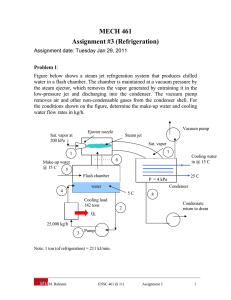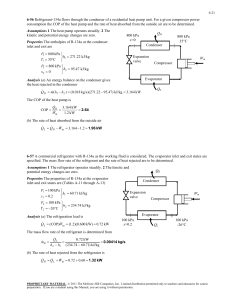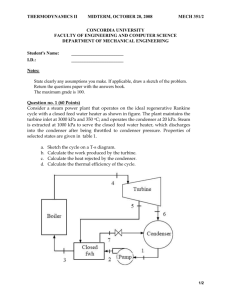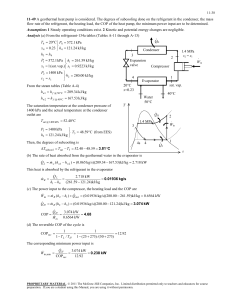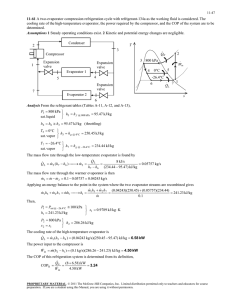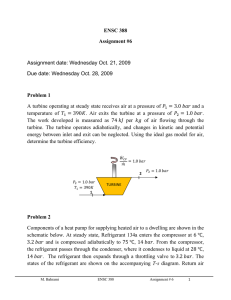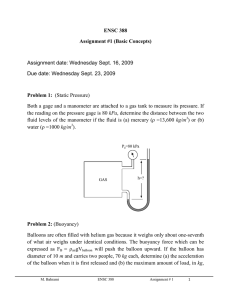MECH 461 Assignment #3 (Refrigeration)
advertisement
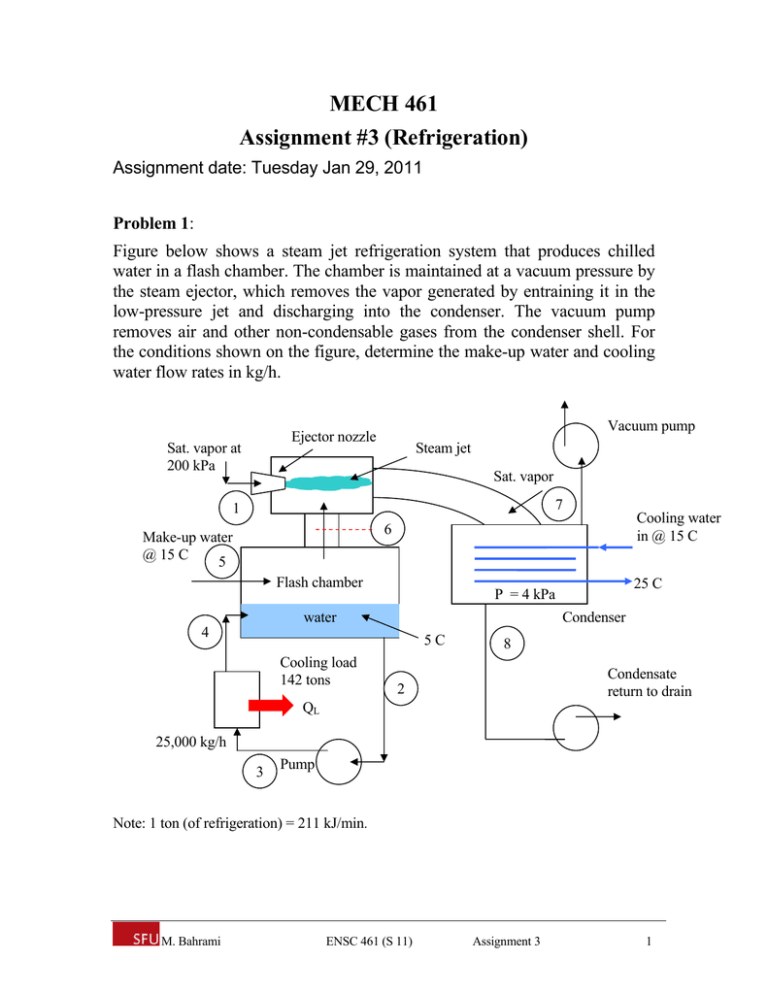
MECH 461 Assignment #3 (Refrigeration) Assignment date: Tuesday Jan 29, 2011 Problem 1: Figure below shows a steam jet refrigeration system that produces chilled water in a flash chamber. The chamber is maintained at a vacuum pressure by the steam ejector, which removes the vapor generated by entraining it in the low-pressure jet and discharging into the condenser. The vacuum pump removes air and other non-condensable gases from the condenser shell. For the conditions shown on the figure, determine the make-up water and cooling water flow rates in kg/h. Vacuum pump Ejector nozzle Sat. vapor at 200 kPa Steam jet Sat. vapor 7 1 Cooling water in @ 15 C 6 Make-up water @ 15 C 5 Flash chamber Condenser water 4 5C Cooling load 142 tons 25 C P = 4 kPa 8 Condensate return to drain 2 QL 25,000 kg/h 3 Pump Note: 1 ton (of refrigeration) = 211 kJ/min. M. Bahrami ENSC 461 (S 11) Assignment 3 1 Problem 2: The schematic diagram of a two evaporator refrigeration cycle is shown in the figure below where refrigerant R-134a is used. The arrangement is used to achieve refrigeration at two different temperatures with a single compressor and a single condenser. The low-temperature evaporator operates at -18C with saturated vapor at its exit and has a refrigerating capacity of 3 tons. The higher-temperature evaporator produces saturated vapor at 3.2 bar at its exit and has a refrigerating capacity of 2 tons. Compression is isentropic to the condenser pressure of 10 bar. There are no significant pressure drops in the flows through the condenser and the two evaporators, and the refrigerant leaves the condenser as saturated liquid at 10 bar. Calculate: 1) the mass flow rate of refrigerant through each evaporator, in kg/min 2) the compressor power input, in kW 3) the rate of heat transfer from the refrigerant passing through the condenser, in kW. Qout 3 2 Condenser Win Expansion valve Compressor 4 Evaporator 2 7 8 1 Expansion valve Qin, 2 = 2 tons Expansion valve 6 Evaporator 1 5 M. Bahrami Qin, 1 = 3 tons ENSC 461 (S 11) Assignment 3 2 Problem 1 Solution: Assumptions: 1) each component is analyzed as a control volume at steady-state 2) the pump work is negligible 3) kinetic and potential energies effects are negligible 4) no heat transfer with the surroundings. Analysis: First we fix each state of the system. State 1: sat. vapor, 200 kPa h1 = 2706.7 kJ/kg State 2: sat. liquid, 5°C h2 = 20.98 kJ/kg State 3: h3 h2 w pump m 2 h2 0 State 4: Q load 142 ton 1.798 10 6 kJ / h h4 h3 1.798 10 6 20 . 98 25,000 m Q load 92.9kJ / kg State 5: T5 = 15°C; h5 ≈ hf (T5) = 62.99 kJ/kg State 6: sat. vapor, 5°C h6 = 2510.6 kJ/kg State 7: sat. vapor, 4 kPa h7 = 2554.4 kJ/kg State 8: sat. liquid, 4 kPa h8 = 121.46 kJ/kg Now, consider a control volume enclosing the flash chamber: m 4 h4 m 5 h5 m 2 h2 m 6 h6 m4 m2 m5 m6 thus m 5 h5 h6 m 2 h2 h4 m 5 734.6 kg / h Next, consider a control volume enclosing the steam jet ejector. m1 h1 m 6 h6 m 7 h7 m 7 m1 m 6 M. Bahrami or, ENSC 461 (S 11) Assignment 3 3 m6 1 m7 m6 m6 h1 h6 h7 0.7766 m7 m7 m 7 945.9 kg / h Finally, for the condenser m 7 h7 h8 m cw hcw,out hcw,in hcw,in = hf (15°C) = 62.99 kJ/kg and hcw,out = 104.89 kJ/kg Thus, m cw 54,920 kg / h Problem 2 Solution: Assumptions: 1) each component is analyzed as a control volume at steady-state 2) all processes are internally reversible, except for throttling through expansion valves 3) the compressor and exp. valves are adiabatic 4) potential and kinetic energies effects are negligible. 2 T P = 10 bar 3 4 3.2 bar -18 C 7 8 5 6 1 s Analysis: Fix each of the principal states: State 3: P3 =10 bar, sat. liquid h3 = 105.29 kJ/kg State 4: Throttling process h4 = h3 = 105.29 kJ/kg State 5: Throttling process h5 = h4 = 105.29 kJ/kg State 6: T6 = -18 °C, sat. vapor h6 = 236.53 kJ/kg M. Bahrami ENSC 461 (S 11) Assignment 3 4 State 7: P7 = 3.2 bar, sat. vapor h7 = 248.66 kJ/kg State 8: Throttling process h8 = h7 = 248.66 kJ/kg Fixing state 1 and 2 requires the mass flow rates through the evaporators. Thus: Q in ,1 Q in ,1 m 6 h6 h5 m6 h6 h5 3tons 211kJ / min 4.823kg / min 236.53 105.29kJ / kg 1ton 2tons 211kJ / min 2.943kg / min 248.66 105.29kJ / kg 1ton and m8 Q in , 2 h7 h4 State 1: Now, for adiabatic mixing streams 6 and 8 to form stream 1: m 6 h6 m 8 h8 m 6 m 8 h1 0 h1 m 6 h6 m 8 h8 241.13kJ / kg m 6 m8 Having the enthalpy and pressure of state 1, the specific entropy is found s1 = 0.9493 kJ/kg.K. State 2: P2 = 10 bar, s2 = s1 h2 = 282.3 kJ/kg b) the compressor power is: w c m 6 m 8 h2 h1 5.329 kW For the condenser Q out m 6 m 8 h2 h3 22.91 kW M. Bahrami ENSC 461 (S 11) Assignment 3 5
